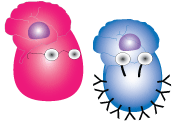
TCR and Ig structure - creating specificity
Immunoglobulins are Y shaped glycoproteins (a stem with 2 arms) consisting of four chains; two identical long heavy (H) chains and two identical short light (L) chains, all held together by disulphide bridges. The TCR is formed from two different chains of the same length which are connected by a single disulphide bridge (shown as yellow lines in the graphic).
Crystallographers found that Ig and TCR chains are built in a very similar way with domains linked together in a daisy-chain. Each domain looks like a woven basket consisting of flat sheets and loops, which we soon will see in the video clip below. The flat sheets form the structural support for the basket, while the loops can vary quite widely in length and shape without causing the structure to collapse. It is these loops that give the antigen specificity to our Igs and TCR molecules.
Compare the structure of the Ig and the TCR in the graphic. Can you see that the Ig L chain and TCR chains consist of 2 domains each, while Ig H chains consist of either 3 or 4 domains. Don't you think that structurally the two TCR chains together look very similar to an arm of the Ig made up of the whole light chain and a portion of the heavy chain? In this video you can see how the sheets and loops make up the structure of an Ig. Keeping in mind how similar in structure an arm of an Ig and a TCR are, can you find out which domains have the loops that give Ig and TCR their antigen specificity?
The domains of Ig and TCR chains that contact antigen are called the variable domains. All of the other domains are called constant region domains. There are 5 different kinds of Ig H chain constant regions which also defines the different Ig classes or isotypes that we have; IgM, IgG, IgD, IgA and IgE. There are 2 different kinds of L chain constant regions and 4 different kinds of TCR constant regions. In 95% of T cells, the TCR consists of an alpha (α) and a beta (β) chain pair and the remaining 5% consist of gamma (γ) and delta (δ) chain pairs.
As shown in the video, it is when the variable domains of paired chains snuggle close to each other that 6 loops, 3 from each chain, act as finger tips that can grip only to antigens which are complementary in shape. It is the shape of the 6 loops together that gives each Ig and TCR its unique antigen specificity. Ig bind antigen in its native form while TCR bind antigen as peptide fragments in the grooves of MHC molecules as we have seen in the linker module. Both Ig and TCR are quite picky about what they bind. Recognizing shapes and the ability to hold on tight are fundamental features of the adaptive immune system.